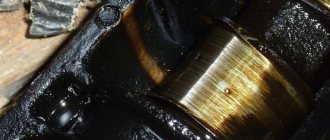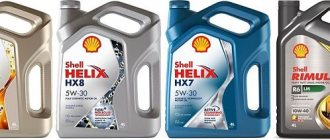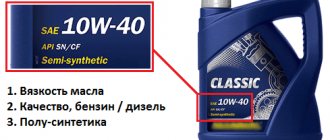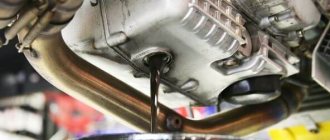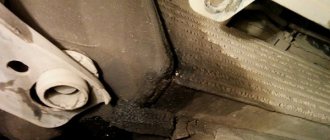Even novice motorists know that motor oil is a consumable item. But many of them perceive this as the need for periodic replacement at scheduled times, forgetting that there is also a natural consumption as a result of burning a certain amount of it when the power unit is running. In normal condition, this consumption is small, so many car owners simply do not notice it. But even if the lubricant level has dropped noticeably, as determined by the marks on the dipstick, this does not always indicate the presence of any malfunctions. It is enough to simply add the required amount and continue to operate the car. But if the level decreases frequently, it is worth considering using computer diagnostics to find out the cause of this phenomenon and eliminate it. Of course, the level of engine oil consumption is influenced by many factors - the type of engine, its size, the age of the car or its actual mileage, and even the driving style of the car owner. Therefore, it is so important to know the exact consumption rates of lubricants and be able to determine why these indicators increase over time.
Limits for oil consumption for different engines.
Normal consumption on different engines
Now you should understand in more detail what oil consumption in a car engine is considered normal. It is important to consider the type of power unit used.
Different cars have different motors. Their design and device directly affects the amount of oil consumed.
Therefore, it is worth considering separately:
- gasoline engines;
- diesel engines;
- turbo engines.
To bring some clarity, it is necessary to study each engine and its lubricant consumption in more detail. Everyone has their own oil consumption rate per 1000 km. In addition to 1 thousand kilometers, lubricant consumption per 100 liters of fuel consumed is also often taken into account.
Gasoline engines
Here we are talking purely about naturally aspirated gasoline engines. The presence of a turbo mechanism makes its own adjustments to lubricant consumption, which is why there is a fairly noticeable difference in lubricant consumption.
Regarding the norm for oil consumption in an atmospheric engine running on gasoline, several comments can be made.
- If the car has recently been used, then the normal consumption rate is considered to be from 5 to 25 grams per 100 liters of fuel. During the break-in period, when the car has just been purchased, consumption increases significantly for a while, and then returns to normal. This is due to the grinding in of parts.
- Used cars can consume about 25-100 grams of oil for every 100 liters of fuel consumed. These are gasoline power units that are in good condition and have average mileage. There are no technical problems observed.
- If a vehicle with a gasoline engine consumes more than 300-400 grams of oil per 100 liters, then this value is already considered critical. In such a situation, the risk of engine jamming increases. Therefore, it is imperative to visit a car service center and eliminate the reasons that influence the increased consumption.
- For certain gasoline engines, the critical point is considered to be a consumption of 800 grams of lubricant. But these are excessively high indicators that cannot be ignored. Even 400 ml. oils already require immediate action on the part of the car owner.
It is recommended to constantly monitor consumption. This is especially true for fairly old cars that have traveled hundreds of kilometers.
Turbocharged engines
The maximum permissible oil consumption in an engine with a turbocharger significantly exceeds that of a conventional naturally aspirated engine. And this applies to both gasoline and diesel engines.
A large number of new turbo engines are appearing on the market, capable of boasting solid power with a small displacement. Here, lubricant consumption is directly related to power indicators. It is turbo engines that have the highest engine oil consumption rate. Some people are scared by such indicators, but in practice these are completely natural costs.
If this is a new turbocharged engine, then it may well consume about 80 grams of lubricant for every 100 liters of fuel or for every 1000 kilometers. Moreover, this applies to conventional turbo engines with one turbine. The motor needs high-quality lubricant in large quantities. And when there are several turbines, the consumption rate increases several times. And this is considered the norm.
Worn turbo units require more lubrication. In certain situations, the car begins to consume about 2 liters per 1000 kilometers. When the turbo system is in a faulty state, consumption rises to even more shocking levels.
If you notice that a turbocharged power unit begins to consume more than 2 liters after traveling 1000 kilometers or burning 100 liters of fuel, go to a diagnostic center. It is imperative to find the cause of the malfunction, eliminate it, and return the consumption to normal levels.
Diesel engines
Here, the consumption figures for waste are not very different from turbocharged engines, but differ significantly from conventional naturally aspirated gasoline engines. And this norm is sometimes misleading, although in fact the oil consumption is quite adequate. It’s just that compared to a gasoline engine, a diesel engine really needs more lubrication.
Diesels are closer to turbocharged power plants than to naturally aspirated gasoline engines. Therefore, the normal consumption of motor oil in a diesel engine is 30-50 grams for every 100 liters of fuel or per 1000 kilometers.
There are definitely problems with your engine when consumption increases to 200 grams per 1000 kilometers. Here you need to visit a car service center.
If a diesel vehicle is operated under load, heavy loads are transported, or the vehicle is operated in difficult conditions, the level of lubricant consumption will also increase. And this will be considered the norm.
What engine oil consumption is considered normal?
It is necessary to determine the rate of oil consumption by the volume spent per hundred liters of fuel. Running in a new engine up to five thousand kilometers ensures oil consumption of up to 1 l/1000 km on average. A similar amount will be consumed when changing piston rings.
Lubricant consumption limits for a mileage from five to one hundred and fifty thousand kilometers in l/1000 km:
If the mileage is more than one hundred and fifty thousand, the normal figure will change and will be from 0.35 to 0.55 l/1000 km due to wear of parts.
Source
Reasons for overspending
Lubricant consumption in the engine can be natural or unnatural. The first occurs when the engine is running, which requires a certain amount of lubricant to function properly.
But there are other reasons that influence the increase in consumption above the norm.
- Excess. Many car owners do not know or simply forget that it is impossible to pour excess lubricant into the engine crankcase. Also, sometimes this happens when the rules for changing the lubricant are not followed. If there is more oil than normal, it begins to push itself through the holes inside the engine. As a result, volatilization occurs through the ventilation system and more. You have to top it up again after a while.
- Cheap lubricant. Each car owner decides independently which oil to use for the engine. Basically, it is important to take into account the characteristics of the liquid, but many people forget about quality. Low-quality lubricants have minimal viscosity and tend to evaporate quickly.
- Increased load on the engine. If you are a fan of fast and aggressive driving and constantly load the engine, then the lubricant consumption will increase. Operating conditions, soil type, weather conditions, vehicle load, etc. play an important role.
- Air temperature. An extremely simple rule applies here. The higher the ambient temperature, the more oil will be consumed. Therefore, lubricant is added more often in summer than in winter.
- Factor of physical losses. This phenomenon is often associated with problems with the oil filter or poor sealing of the power plant. Quite often, the cylinder head gasket stops functioning normally, and the tightening of the mounting bolts becomes loose.
- Violation of the lubricant replacement regime. The frequency of oil changes for each car and engine is individual, as it depends on a large number of factors. But it is not recommended to change the lubricant less than once per 10 thousand kilometers. This is usually done after 5-7 thousand kilometers. If you do not follow these recommendations, old worn-out oil will not only be consumed more actively, but also create serious problems for your engine.
By manufacturer
Of no less interest is the flow rate parameter for different manufacturers.
| Manufacturer | Oil consumption per 1000 km |
| Hyundai | 1l. |
| Kia | 0,6 |
| VW | 0,5 |
| Honda | 1l. |
| Toyota | 1 l |
| Renault | 0.5 l |
| Mazda | 0,8 |
| VAZ | 0,7 |
| Granta 8 valve | 0,5 |
Those. From here we can draw a preliminary conclusion that any motor oil tends to burn in an acceptable volume.
But if the engine begins to burn oil, then it is worth paying attention to the quality of the filled working lubricant and the technical condition of the engine.
The influence of engine elements on lubricant consumption
Inside the engine there is a certain amount of lubricating fluid, which is provided individually for each car and engine.
If the natural consumption of lubricant exceeds established standards, the reasons for the increased consumption of lubricant should be found. Here some components, systems and assemblies of the power plant can play a big role.
- Cylinder block. The most common problem with the block is the formation of a leak in the gasket, which is located between the block and the cover. Moreover, such a malfunction is often easy to detect by visual inspection of the engine compartment.
- Crankshaft. The crankshaft can also affect increased lubricating oil consumption in the engine. As in the previous case, the seals often leak here, which is due to their severe wear. To identify the problem, you need to disassemble the engine. Worn oil seals must be replaced with new ones.
- Oil filter. The engine has a special filter that cleans the oil. Over time, due to the formation of sediment and chips from rubbing parts, contamination occurs. This increases oil consumption. Or there is the possibility that the filter was not tightened tightly enough. This is also where the problem of overspending comes into play.
- Timing valves. Due to overheating, oil seals on many cars fail. Because of this, oil gradually seeps into the gas distribution mechanism. To solve the problem, you need to change the worn caps;
- Oil scraper rings. If the rings on the pistons wear out, an overflow problem arises. This is a fairly common phenomenon in engine operation. Such a malfunction can be determined by the bluish smoke that will come out through the exhaust pipe of the vehicle. This is due to oil evaporation. To eliminate the overexpenditure, you will have to replace the rings with new ones.
- Cylinders. High temperatures lead to the fact that the cylinders begin to wear out more actively, and scuffs form on their internal surfaces. Lubricant begins to penetrate into these cracks, which entails increased consumption of lubricant. In some situations, the problem is solved by replacing oil scrapers or piston rings. But sometimes you have to bore or grind the cylinders. And this is a much more complex and expensive procedure.
- Turbine. During operation, the turbocharger mechanism constantly pumps air, which leads to excessive heating. During operation, the turbine requires a large amount of lubrication. Therefore, overexpenditure is often explained by the presence of a turbine. It itself requires a lot of oil, and in case of malfunctions or wear of the turbo mechanism, consumption increases several times.
As you can clearly see, there are many reasons for increased engine oil consumption. There are certain standards specific to each specific engine.
What determines engine oil consumption and how to reduce it
As mentioned above, oil is consumed in any engine, since the oil film on parts to protect against dry friction burns in the chamber along with the fuel charge. If we add to this the natural wear and tear of the internal combustion engine during operation, then lubricant consumption further increases.
The fact is that at many service stations, technicians prefer not to diagnose a separate cause of increased oil consumption, but immediately offer the owner to make major repairs. It is important to consider that such expensive repairs are not always necessary.
In various situations, lubricant can flow along the external surface (leak out) and also penetrate into other systems. For example, if oil is leaking between the transmission and the engine, the crankshaft seal is at fault, and a puddle may form under the car.
If the cylinder head gasket turns out to be problematic, there may not be any leaks on the outside, the engine will be dry. In this case, the lubricant will enter the coolant, the coolant will become cloudy, the oil in the engine will also begin to foam, and an emulsion will appear under the oil filler cap and on the dipstick.
However, even in such a situation, you can try to fight the waste before agreeing to repairs. First of all, lubricant consumption depends on the operating mode of the motor. In other words, driving at high speeds leads to an increase in temperature and loads, the oil thins out, is less easily removed by rings from the cylinder walls, burns out, etc.
Taking into account the above, it becomes clear that you need to use the most suitable oil both in terms of tolerances and high temperature viscosity index. For example, from the list of recommended lubricants in the manual, you need to select a product with a higher viscosity compared to what is currently filled.
You can also switch from synthetics to semi-synthetics, which in some cases also allows you to reduce lubricant consumption. The main thing is that such semi-synthetics are allowed for use in a specific internal combustion engine and comply with the recommendations of the engine manufacturer.
The main reason for failure of valve seals is their drying out and hardening, since the elements are made of rubber. Also, the seals can be affected by oil that is unsuitable for the engine, which has an aggressive effect on the rubber.
Simply put, the accumulation of soot and coke does not allow the ring to move in the groove, that is, the rings are stuck. Reduced mobility means that the ring does not perform its function, the oil is poorly removed from the walls and burns out in the combustion chamber.
Each of the solutions has both its pros and cons, however, for a worn engine, in many cases it is possible to reduce lubricant consumption and extend the life of the engine until overhaul.
As a result, the lubricant enters the cylinders through the intake, after which it burns in the engine along with the fuel. In such a situation, it is necessary to diagnose and clean the crankcase ventilation system.
Reasons for increased oil consumption
A noticeable increase in engine oil consumption, as already noted, is a natural phenomenon, but there may be several reasons for such a situation. Let's try to figure out what exactly has the greatest impact on the degree of increase in lubricant consumption and whether it is possible (and how justified) to combat this. In most cases, oil is consumed more than normal due to overheating of rubbing parts (evaporation) or as a result of an increase in technological gaps (leakage). Some problems simply indicate wear and tear, which is not critical for the engine, and its elimination requires expensive overhauls. Other reasons may indicate the presence of very serious problems, without urgent correction of which the engine may soon fail.
Cylinder block
Perhaps the most common cause of MM leakage is a violation of the integrity of the BC gasket. This situation usually occurs either as a result of improper tightening of the bolts, or due to overheating of the motor. The method for diagnosing the problem is quite simple - visual inspection of the power unit. The presence of damage to the gasket will be indicated by oil leaks present in the area of the gasket. According to statistics, aluminum motors are especially prone to this problem. If traces of MM are found on the engine, the problem should be corrected. It is quite possible that to do this it is enough to tighten the bolts that are not tightened enough, but more often the reason lies in the curvature of the surface of the BC head. In this case, it must be aligned and the gasket must be replaced.
Crankshaft
The second common reason for increased engine oil consumption is lubricant leakage through the oil seals. This will be indicated by MM leaks under the power unit. The cause of the leak is wear of the edges of the sealing elements. This result can lead to:
- use of low-quality seals;
- use of oils not recommended by the car manufacturer;
- long-term operation of the lubricant (exceeding the scheduled replacement periods).
The second reason is most common, especially for outdated car models. The problem is relatively easily resolved by replacing leaking seals.
Oil filter
A poorly screwed oil filter is an uncommon cause of lubricant leakage, most often occurring when inexperienced car owners replace this consumable on their own. Typically, to ensure the required tightness, the O-ring is lubricated with a small amount of MM. Beginners do not take this nuance into account, and when screwing in the oil filter, they use insufficient force, which leads to a leak. If the problem cannot be resolved, it is better to replace the oil filter with a new one.
valves
Leakage of oil seals operating at high temperatures is also considered a natural phenomenon, since over time the rubber loses its elastic characteristics and the caps are no longer able to provide a complete seal. In such cases, lubricant leakage can occur both during the exhaust and intake stages. A layer consisting of oil and fuel assembly deposits forms inside the valves, significantly worsening the engine’s throttle response. To solve the problem, replace the caps related to consumables.
What engine oil consumption is considered normal?
Engine oil is an important process fluid that ensures efficient and uninterrupted operation. For a number of reasons, its decline occurs. Moreover, this value may indicate the general condition of the power unit. That is why many car owners are concerned about the question of what is normal engine oil consumption, and is it possible to reduce it?
Content
Oil consumption for diesel engine waste: calculation
Diesel engines, unlike gasoline engines, have been more voracious in terms of oil consumption throughout all periods of the automotive industry. The point is in the specifics of the work: the compression ratio and, in general, the voltage on the crankshaft parts of diesel engines is higher.
Often motorists do not know how to independently calculate the oil consumption of the engine due to waste. To date, several methods are known.
The first and simplest is the topping method. Initially, during the next maintenance, you need to fill the oil strictly according to the upper mark on the dipstick. After 1000 km, gradually add oil from a liter container until the same level is reached. Based on the residue in the canister, you can understand how much oil the car consumed due to waste. Control measurements should be made under the same conditions as at the time of maintenance. For example, if the oil level was checked on a hot engine, then after topping up this should be done under the same conditions. Otherwise, the result obtained may differ significantly from the actual oil consumption of the engine.
The second method will give a more accurate result. Completely drain the oil from the crankcase during maintenance. Fill it fresh to the top mark on the dipstick and check how much is left in the canister. For example, we pour the remainder into a measuring container for a more accurate result, but you can also use the measuring scale on the canister as a guide. We subtract the remainder from the nominal volume of the canister - we get the amount of oil poured into the engine. While driving, over 15 thousand km (or other mileage regulated by the car manufacturer), add oil to the mark and count it. It’s most convenient to simply top up with liter jars. Typically the difference between the marks on the dipstick is about a liter. After the next maintenance, drain the oil from the crankcase and measure its quantity. We subtract the amount of drained waste from the initially filled volume of oil. To the resulting value we add the entire volume of lubricant that was filled in over 15 thousand kilometers. We divide the resulting value by 15. This will be the volume of oil that burns out per 1000 km of run in your car. The advantage of this method is a large sample, which eliminates operational errors that are typical for measurements at short mileage.
Then we simply compare the obtained value with the passport data. If the waste consumption is within the norm, we drive on and don’t worry. If it exceeds the passport values, it is advisable to carry out diagnostics and find out the reasons for the increased oil consumption.
Looking for a reason
The internal combustion engine is an open system. This means that it has an input and output, and cannot function autonomously. In this regard, even the most economical engine requires refueling after 1000 km, and it is not superfluous to carry out a preventive inspection and check of all components and parts at this time.
Why fuel burns is probably clear to everyone: with each movement of the piston, the maximum permissible portion of the mixture is injected into the cylinder, which immediately burns and moves the connecting rods upward. But at the same time, oil is also consumed: after 1000 km its amount noticeably decreases, and in some cases, motor lubrication requires topping up even when maintenance is not yet required to be performed according to regulations.
It is obvious that engine oil consumption is a stable norm. To get an answer to the question of why lubricant is generally consumed and becomes less abundant over time, it is worth learning more about the processes that occur in the engine during its operation. Firstly, fuel is constantly burned in it. And if in gasoline units the combustion temperature reaches 300–500 degrees, then the glow plugs in a diesel engine heat up to 900 degrees, which is the absolute norm.
Of course, temperature overloads affect engine oil consumption and significantly increase it. But, on the other hand, this is the norm, because even after 1000 km of travel, the liquid, which is designed to reduce the load on moving engine parts, will inevitably burn out.
In addition, in a motor you always have to deal with friction. Moreover, the norm is speeds up to 8000 per minute: this generates incredibly high heating. This is where additives come into play: they neutralize the damage that occurs during such friction and are inevitably consumed. Since there are fewer additives, after 1000 km the lubricant level will noticeably drop. This will lead to the need for regular checks and perhaps topping up lubricant in order to avoid further problems with the engine and all its components.
How to use the calculator
One of the main roles in this calculation is played by the volume of fuel burned and the volume of operating oil, as well as the type of engine. It is in relation to this volume and specifics of work that the specific oil consumption is calculated.
To calculate specific engine oil consumption, the following data is required:
- In the “fuel” field, enter the average fuel consumption in liters per 1`000 km. mileage (by default and based on calculation formulas this is 100 liters);
- In the “oil” field - the volume of oil that is regulated by the manufacturer as necessary when filling;
- Select the engine type and check if the machine has been in use for more than 5 years
- Click "calculate".
Such a calculation calculator can be an indispensable assistant for calculating the consumption rate of lubricants intended for operational accounting of the specific consumption of motor oil when justifying the need for them. After all, if not all, then many car enthusiasts have a rather wary attitude towards engine oil consumption. This service will show whether you are within the nominal values. If not, then you will have an objective reason to look for reasons and possible problems.
What's the outcome
That is, if the engine is in order, then it takes practically no oil, and you will not need to top it up until the next change. Its level will be within acceptable limits on the dipstick (within the min./max. marks). But there are cases when the manufacturer indicates consumption rates for a specific power unit (some engines eat oil), then topping it up is considered natural and is not a malfunction, but on average it does not exceed 1-2 glasses from replacement to replacement.
It is important to understand that the harder the engine runs, the more oil it burns. For example, the higher the number of revolutions, the more oil will remain in the cylinders of the car engine. Although we should not forget not only about the operating mode of the engine, but also its design. You should also not neglect the tolerances of motor oils and fill in fuels and lubricants of dubious quality.
It will be useful: Knock sensor VAZ 2114: where is it located, replacement
Subscribe
to our channel in
Index.Zen
Even more useful tips in a convenient format
Shizgar › Blog › Oil consumption, oil waste or everything about motor oil!
What is high oil consumption?
I found some information on the net from the officials
The oil consumption rate for waste for all types of Mitsubishi engines is no more than 1 liter per 3000 km (or 3 l/10,000 km or 5 l/15,000 km).
Official response from the MMC representative office
During normal operation for Mitsubishi cars, the Manufacturer considers acceptable engine oil consumption not exceeding 1 l/3000 km. Please note that oil consumption depends not only on the technical condition of the engine, but also on the operating characteristics of the vehicle, such as road conditions, speed, vehicle load, etc. The specified standard is provided for all Mitsubishi car models, regardless of type, engine size and configuration.
The guy talks about the theory of internal combustion engines and talks a lot but to the point:
To begin with, a rhetorical question: is a liter of oil per 5000 km a lot or a little? Everything is individual, for V6 or V8 engines this is almost within the norm, for in-line small cars this is definitely a lot. You must understand that any engine, even a completely new one, consumes oil. Actually, the engine oil simply burns away in the cylinders, remaining on their walls. This is its purpose - to cover all internal surfaces with a film and prevent dry friction. And this film burns in the chamber along with the fuel mixture.
The only question is how much oil is burned in your engine and whether you need to do something about it. The experience of many owners of used cars shows that even in a fairly worn-out engine, in most cases it is more profitable to simply add oil than to do a major overhaul.
In fact, there are slightly more reasons for increased oil consumption than, in the language of service station “specialists,” simply a “dead engine.” The engine oil can burn excessively, or it can also simply leak. And diagnosing the real cause of increased oil consumption in most engines is actually quite difficult. Moreover, some reasons are determined only by opening them, and therefore often after major repairs the craftsmen do not tell the owners exactly what the reason was in their case. And all because in many situations, engine overhaul is far from the most optimal way out of the situation.
Well, everything seems to be clear here - if the oil leaks, you need to change the gaskets, seals, and so on. Oil may leak from the engine in the following places (the most common problems):
Valve cover gasket. This is on top of the engine; in case of insufficient sealing, oil leaks are clearly visible on the outer side walls of the engine. As a rule, a lot of oil cannot escape through this gasket, but the tightness of the system must be restored in any case. Cylinder head gasket (cylinder head). Also in the upper part of the engine, under the cylinder head. This gasket (there are two of them in V-shaped engines, like the cylinder head) can be damaged in different places, as a result of which oil can leak out (the symptoms are the same as with the valve cover gasket), in addition, oil can leak into the system cooling, if that part of the gasket that is located between the working cylinders and the holes of the cooling system is broken. In this case, the engine will be externally dry, but the coolant will be cloudy and change color, and the oil in the engine will foam (foam can be seen on the inside surface of the filler cap through which oil is poured into the engine). This problem needs to be solved urgently, because it is dangerous to the life of the engine (due to coolant getting into the engine oil). Crankshaft and camshaft seals. Not on all engines such a leak can be seen by simply opening the hood. But there should be smudges from the bottom of the engine plus spots (puddles) of oil on the inner surface of the crankcase protection. This problem, just like any other leak, needs to be fixed as soon as possible. Oil pan gasket. This leak can only be seen on the lift and with the protection removed. Pay attention to this the next time you change the oil. Rear crankshaft oil seal (at the entrance to the gearbox). In most cases, this oil seal is changed only when the gearbox is removed, and it is impossible to see it. But again, a leak can be diagnosed by smudges in the lower part of the engine on the gearbox side. Gasket under the oil filter. Don't smile - it's actually not that uncommon. The question here is about the quality of the filter and its replacement. Replacing the gasket is quite simple. Burnt oil
Engine oil waste itself is quite easy to diagnose. When oil burns in the engine, it produces bluish smoke in the exhaust, which cannot happen when high-quality gasoline is burned (black smoke, as a rule, means that the injection is not working properly). In addition, if the engine burns oil over a long period of time beyond normal limits, an oily black edge forms on the edges of the exhaust pipe.
It is much more difficult to understand the cause of oil burnout. Without opening the engine, no one can definitely tell you the reason for the increased consumption of engine oil. But at the same time, there are a number of relatively inexpensive and uncomplicated ways to combat waste that can be tried before opening the engine.
First, you should note that oil burns in every engine! It simply cannot help but burn out completely, since it constantly forms an oil film on the internal surfaces of the working cylinders, where the fuel ignites. A much more important question is how much oil is burned in your engine and what is the burn rate for it.
The next important point is that the amount of oil burned directly depends on the operating mode of the engine. The more often the engine runs at high speeds, the more oil it will burn, and this has nothing to do with the condition of the engine itself. The laws of physics work here - the higher the speed, the higher the temperature of the engine and oil, respectively, the thinner the oil -> more oil remains in the working cylinders. Why does oil burn and how to deal with it?
Here are the main reasons why motor oil burns in the engine:
An oil that is not suitable for this engine has been filled in. For information on how to find out which oil is suitable for your engine, read the car's operating manual. In short and to the point, oil with too low a viscosity will simply sit in the cylinders and burn, while oil with too high a viscosity will form too thick a film on the inner walls. In both cases this will lead to increased oil consumption. The treatment method is simple - pour suitable oil into the engine. You'll be surprised how this can affect your engine oil consumption. In this case, from all the options allowed by the car manufacturer for a given engine, you should choose the oil whose viscosity is higher than what is currently filled. Switching from synthetic oil to semi-synthetic very often solves the problem of oil consumption. In this case, there is no harm to the engine, provided that semi-synthetics with these parameters do not contradict the recommendations of the car manufacturer. Worn valve seals (oil seals). In many engines, these seals can be replaced without even removing the cylinder head (cylinder head), and the price of this strategic spare part will surprise you with its insignificance. And oil consumption can decrease significantly. The problem can only be diagnosed indirectly by the compression values, but you will definitely understand everything only after replacement. The cause of wear on valve seals is temperature changes or unsuitable engine oil that is incompatible with the rubber from which they are made. Worn piston (oil scraper) rings. There's nothing you can do about it; ideally, the rings need to be replaced, and in most cases this results in a full engine overhaul. True, you can also try to do the so-called “decarbonization” of the rings (often helps cars after a long period of inactivity). The easiest way to “decarbonize” is to go out onto the highway and drive a dozen or two kilometers at significantly increased speeds, closer to the red zone on the tachometer. In addition, special chemicals for this are sold, which are added to the spark plug holes before “decarbonization,” but to be honest, the safety of such chemicals for the engine in the future is a big question. Damage or wear of the internal surfaces of the cylinders (wear-out), as well as other internal engine parts. Such problems simply cannot be solved and are usually accompanied by extraneous sounds when the engine is running. The cause of these malfunctions is the entry of dust and dirt into the engine, untimely replacement of oil and filters, low-quality oil, the use of foreign additives, and much more. It must be said that simply the age or mileage of the engine cannot cause an immediate increase in oil consumption; in this case, the consumption increases gradually and very slowly. The recipe in this case is to try to switch to a more viscous oil (from the one possible according to the engine manufacturer’s tolerances), change the valve seals and see what the oil consumption will be after that. If this is a few liters between changes, it is more profitable to simply add oil, while at the same time setting aside funds to replace the engine or car. A major overhaul in this case is a lottery with very little chance of success. High pressure of crankcase gases, or the turbine (compressor) has failed. In such cases, oil enters the cylinders directly through fuel injection from the crankcase ventilation system. High pressure of crankcase gases is typical for worn-out engines, and is a consequence of the reasons described above, but the turbine can be repaired or replaced. In addition, a faulty turbine (compressor) is fairly easy to diagnose.
It will be useful: Michelin tires: sizes, tests, reviews
